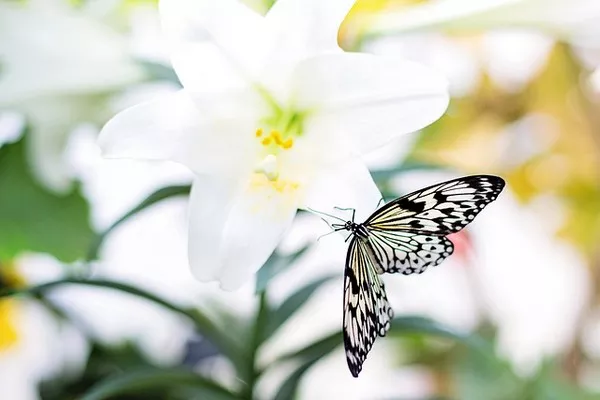The intricate dance between flowers and butterflies has long enchanted nature enthusiasts and scientists alike. The sight of butterflies fluttering amidst a sea of vibrant blooms is a spectacle that evokes feelings of wonder and beauty. But what exactly draws these delicate creatures to particular flowers? The attraction between butterflies and flowers is not merely a visual spectacle; it is a symbiotic relationship that serves vital ecological roles. This article delves into the world of butterfly-flower interactions, exploring the factors that make certain flowers irresistible to these winged wonders.
The Evolutionary Tango
The captivating dance between butterflies and flowers is an example of coevolution, where two species influence each other’s evolutionary trajectory. As butterflies seek nectar for sustenance, they inadvertently perform the vital function of pollination. This process helps flowering plants reproduce by transferring pollen between flowers, enabling the production of seeds and new plants.
Color Palette: A Visual Feast
One of the most conspicuous features that attract butterflies to flowers is color. Butterflies are known for their exquisite vision, which allows them to perceive a broader spectrum of colors than humans can. They are particularly drawn to vibrant hues such as red, orange, yellow, and purple. These colors signal the presence of nectar-rich flowers, acting as beacons that guide butterflies to a rewarding food source. The brilliant red blossoms of the bee balm (Monarda) and the vivid orange trumpets of trumpet vines (Campsis radicans) are prime examples of flowers that exploit the butterflies’ color preferences.
Shape and Structure: Landing Pads
Beyond color, the shape and structure of flowers also play a crucial role in attracting butterflies. Butterflies have specialized mouthparts called proboscises that allow them to sip nectar from tubular flowers. Flowers with open, flat surfaces like daisies and zinnias provide an easy landing platform for butterflies to alight and feed. Orchids, on the other hand, have intricate shapes that offer convenient landing spots and direct access to nectar.
Fragrance: A Perfumed Invitation
While visual cues are paramount, fragrance serves as an additional lure for butterflies. Many flowers emit scents that are not only pleasant to human noses but also irresistible to butterflies. These scents often signal the presence of nectar and are a critical factor in attracting butterflies from a distance. Flowers such as lavender, lilac, and phlox release fragrances that are particularly enticing to these insects, enhancing the probability of successful pollination.
Nectar Accessibility: The Reward Factor
The accessibility of nectar within flowers is another determinant of their attractiveness to butterflies. Flowers with easily accessible nectar are more likely to draw these pollinators. Shallow flowers with a broad landing area and readily available nectar are ideal for butterflies, as they can easily extend their proboscises to access the sweet reward. Examples of such flowers include sunflowers, coneflowers, and asters.
Blooming Period: Timing Matters
The timing of flower blooms aligning with the active periods of butterflies is essential for successful pollination. Many butterfly species are seasonal, with specific flight periods that correspond to the availability of their preferred nectar sources. Flowers that synchronize their blooming period with the butterfly’s flight season ensure a reliable food source for these insects. For instance, milkweed plants (Asclepias) bloom during the summer, coinciding with the migration of monarch butterflies.
Host Plants: Beyond Nectar
While nectar-rich flowers are crucial for adult butterflies, the relationship extends further. Host plants, where butterflies lay their eggs and caterpillars feed, play a significant role in attracting these insects. Different butterfly species have specific host plant preferences, as their caterpillars are adapted to feed on specific plant species. Providing a suitable habitat for caterpillars is essential for maintaining healthy butterfly populations. For example, the monarch butterfly relies on milkweed plants as its exclusive host plant.
Avoiding Predators: Camouflage and Mimicry
In the complex world of nature, butterflies are not the only creatures attracted to flowers. Predators like birds and insects also seek to exploit these nectar sources. To counteract this, some butterflies have developed unique adaptations to deter potential threats. Cryptic coloration, also known as camouflage, helps butterflies blend into their surroundings, making them less visible to predators. Additionally, certain species of butterflies mimic the appearance of toxic or unpalatable insects to discourage predators from attacking them.
Conclusion
The captivating relationship between butterflies and flowers is a testament to the intricate web of interdependence in the natural world. Through the evolution of color, shape, fragrance, and timing, flowers have crafted an irresistible allure that draws butterflies in, facilitating pollination and enabling the continuation of both species. By understanding the intricate mechanisms behind this symbiotic dance, we can better appreciate the delicate balance that sustains the biodiversity of our ecosystems. As we marvel at the enchanting sight of butterflies flitting among blooms, we are reminded of the profound connections that shape the living tapestry of our planet.


